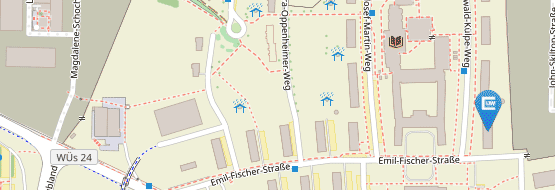Ly Tung Nam's research visits to Dresden and Lyon / France
18.12.2013Supported by the Bayerische Forschungsstiftung, Ly Tung Nam has recently visited our partner laboratories at Dresden and Lyon / France for the discussion of important topics around his project on the intelligent orientation and navigation assistance in complex enviroments for people with dementia. Here is his travel report:
First travel – Dresden:
I visited Dresden on 25 – November – 2013. The main purpose of this visit was to get in touch with people with dementia, the key factor of my project’s context. During my stay, I visited a nursing house. I also had the opportunity to discuss with Dr. Gesine Marquardt, Kathrin Büter (M.Arch.), and Tom Motzek (M.Sc. Health Scientist), who are experts on architectural design for people with dementia, and who work frequently with them.
I realized that the main problems for people with dementia are a lack of orientation (where they are), a lack of social activity (interaction with the environment and other people), and the risk of getting lost. Then, I observed and learned some approaches of architectural design and organization such as floor-plans, color markers, pictures, names, light contrast, and memorable reference points.
Besides that, the complexity of the various environments (hospital, nursing house, private home, indoor, outdoor) and the effects of the different degrees of the disease (mild, moderate, serve degree) made me wonder about what assistive technology might work best for them. For instance, people with severe impairment (often at very advanced ages) are generally very sensible and not really willing to wear any equipment such as smartphone, smart-watch, or head phones. This made me think about invisible assistive technology.
Second Travel – Lyon:
I have spent one week in Lyon (from 16th – 20th of December, 2013) discussing with colleagues and preparing for the next phase of the project: Model and develop. Given the context “navigation for people with dementia in complex environment”, one important aim is to find out how to develop a robust classification scheme for determining intentions and activities, as well as to design cognitive models for simulating the effects of assistance offers. In addition, choosing and integrating appropriate commodity technology for context clarification, and display of / interaction with subtle means of navigation aids are other relevant points to consider.
Firstly, I discussed about plan, goal, activity, and intention recognition with Prof. Samir Aknine (GrAMA at LIRIS, Université Lyon 1) who is a recognized expert in this domain. Then, we tried to sketch the big steps, including topics such as to model, develop, and test the system, to clarify the scenario, present it in both of informal and formalized ways, and to propose related techniques and algorithms.
After that, I had a meeting with Assoc. Prof. Audrey Serna (SILEX at LIRIS, INSA de Lyon) talking about cognitive modeling. She gave me an overview and many useful references of this area. An interesting and challenging point is how to combine plan recognition and cognitive architectures in complementary ways. Prof. Samir Aknine, Assoc. Prof. Audrey Serna and I have talked over this topic in detail. The final activity of this week was to discuss with Assoc. Prof. Matignon Laetitia (GrAMA at LIRIS, INSA de Lyon) about the decision model and robotics aspects which could potentially become part of the project, too.
Zurück


